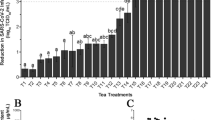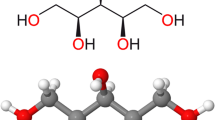Abstract
Periodontal disease is the most prevalent infectious disease, and inflammatory mediators play critical roles in its progression. Therefore, controlling pro-inflammatory cytokine production, especially at initial disease stages, is essential to maintaining gingival and periodontal health. Glycyrrhizin (GL) has an anti-inflammatory effect and has been added to toothpaste and mouth rinse to prevent periodontal disease. However, there is a maximum dose for the use of GL. The aim of the present study is to screen plant extracts which can effectively enhance the effects of GL. The effects of extracts from six different plants on GL-suppressed TNF-α expression in Aggregatibacter actinomycetemcomitans (A.a.)-LPS-stimulated human oral keratinocytes (RT7) were examined. Results demonstrated that Equisetum arvense (EA) extract had the strongest additive effect on the suppression of TNF-α by GL at both mRNA and protein levels. In addition, GL downregulated the production of TNF-α by suppressing NF-κB p65 phosphorylation, but not JNK or p38 phosphorylation. In contrast, EA decreased JNK phosphorylation but not NF-κB p65 or p38 phosphorylation. The combination of GL and EA effectively attenuated A.a.-LPS-induced phosphorylation of NF-κB p65 and JNK. Furthermore, an LPS-induced periodontitis rat model showed that GL with EA supplementation significantly downregulated TNF-α mRNA in the gingival tissue. These results indicate that EA can suppress A.a.-LPS-induced pro-inflammatory cytokine production by inhibiting JNK activation and can promote the anti-inflammatory effects of GL. Our findings suggest that a combination of GL and EA may improve the development of new oral hygiene products aimed at enhancing periodontal health.





Similar content being viewed by others
References
Van Dyke TE, Lester MA, Shapira L. The role of the host response in periodontal disease progression: implications for future treatment strategies. J Periodontol. 1993;64:792–806.
Bertolini DR, Glenn EN, Bringman TS, Smith DD, Mundy GR. Stimulation of bone resorption and inhibition of bone formation in vitro by human tumour necrosis factors. Nature. 1986;319:516–8.
Meyle J. Neutrophil chemotaxis and serum concentration of tumor-necrosis-factor-alpha. J Periodontol Res. 1993;28(6 Pt 2):491–3.
Miyauchi M, Sato S, Kitagawa S, Hiraoka M, Kudo Y, Ogawa I, Zhao M, Takata T. Cytokine expression in rat molar gingival periodontal tissues after topical application of lipopolysaccharide. Histochem Cell Biol. 2001;116:57–62.
Rossomando EF, Kennedy JE, Hadjimichael J. Tumour necrosis factor alpha in gingival crevicular fluid as a possible indicator of periodontal disease in humans. Arch Oral Biol. 1990;35:431–4.
Finney RSH, Somers GF. The anti-inflammatory activity of glycyrrhetinic acid and derivatives. J Pharm Pharmacol. 1958;10:613–20.
Kroes BH, Beukelman CJ, van den Berg AJ, Wolbink GJ, van Dijk H, Labadie RP. Inhibition of human complement by β-glycyrrhetinic acid. Immunology. 1997;90:115–20.
Park HY, Park SH, Yoon HK, Han MJ, Kim DH. Anti-allergic activity of 18beta-glycyrrhetinic acid-3-O-beta-D-glucuronide. Arch Pharm Res. 2004;27:57–60.
Fiore C, Eisenhut M, Krausse R, Ragazzi E, Pellati D, Armanini D, Bielenberg J. Antiviral effects of Glycyrrhiza species. Phytother Res. 2008;22:141–8.
He JX, Akao T, Nishino T, Tani T. The influence of commonly prescribed synthetic drugs for peptic ulcer on the pharmacokinetic fate of glycyrrhizin from Shaoyao-Gancao-tang. Biol Pharm Bull. 2001;24:1395–9.
Wang XR, Hao HG, Chu L. Glycyrrhizin inhibits LPS-induced inflammatory mediator production in endometrial epithelial cells. Microb Pathog. 2017;109:110–3.
Akutagawa K, Fujita T, Ouhara K, Takemura T, Tari M, Kajiya M, Matsuda S, Kuramitsu S, Mizuno N, Shiba H, Kurihara H. Glycyrrhizic acid suppresses inflammation and reduces the increased glucose levels induced by the combination of Porphyromonas gulae and ligature placement in diabetic model mice. Int Immunopharmacol. 2019;68:30–8.
Pinmai K, Chunlaratthanabhorn S, Ngamkitidechakul C, Soonthornchareon N, Hahnvajanawong C. Synergistic growth inhibitory effects of Phyllanthus emblica and Terminalia bellerica extracts with conventional cytotoxic agents: doxorubicin and cisplatin against human hepatocellular carcinoma and lung cancer cells. World J Gastroenterol. 2008;14:1491–7.
Lau KM, Lai KK, Liu CL, Tam JC, To MH, Kwok HF, Lau CP, Ko CH, Leung PC, Fung KP, Poon SK, Lau CB. Synergistic interaction between Astragali Radix and Rehmanniae Radix in a Chinese herbal formula to promote diabetic wound healing. J Ethnopharmacol. 2012;141:250–6.
Sandhu NS, Kaur S, Chopra D. Equisetum aervens: pharmacology and phytochemistry-a review. Asian J Pharmaceut Clin Res. 2010;3:146–50.
Kudo Y, Takata T, Ogawa I, Kaneda T, Sato S, Takekoshi T, Zhao M, Miyauchi M, Nikai H. p27Kip1 accumulation by inhibition of proteasome function induces apoptosis in oral squamous cell carcinoma cells. Clin Cancer Res. 2000;6:916–23.
Kudo Y, Takata T, Ogawa I, Kaneda T, Sato S, Takekoshi T, Zhao M, Miyauchi M, Nikai H. p27Kip1 accumulation by inhibition of proteasome function induces apoptosis in oral squamous cell carcinoma cells. Clin Cancer Res. 2000;6:916–23.
Yamano E, Miyauchi M, Furusyo H, Kawazoe A, Ishikado A, Makino T, Tanne K, Tanaka E, Takata T. Inhibitory effects of orally administrated liposomal bovine lactoferrin on the LPS-inducedosteoclastogenesis. Lab Invest. 2010;90:1236–46.
Furusho H, Miyauchi M, Hyogo H, Inubushi T, Ao M, Ouhara K, Hisatune J, Kurihara H, Sugai M, Hayes CN, Nakahara T, Aikata H, Takahashi S, Chayama K, Takata T. Dental infection of porphyromonas gingivalis exacerbates high fat diet-induced steatohepatitis in mice. J Gastroenterol. 2013;48:1259–70.
Hothorn T, Bretz F, Westfall P. Simultaneous inference in general parametric models. Biom J. 2008;50:346–63.
Fujimoto R, Kamata N, Yokoyama K, Taki M, Tomonari M, Tsutsumi S, Yamanouchi H, Nagayama M. Establishment of immortalized human oral keratinocytes by gene transfer of a telomerase component. J Jpn Oral Muco Membr. 2002;8:1–8.
Rebaï O, Le Petit-Thevenin J, Bruneau N, Lombardo D, Vérine A. In vitro angiogenic effects of pancreatic bile salt-dependent lipase. Arterioscler Thromb Vasc Biol. 2005;25:359–64.
Dai J, Peng L, Fan K, Wang H, Wei R, Ji G, Cai J, Lu B, Li B, Zhang D, Kang Y, Tan M, Qian W, Guo Y. Osteopontin induces angiogenesis through activation of PI3K/AKT and ERK1/2 in endothelial cells. Oncogene. 2009;28:3412–22.
Zhang N, Lv H, Shi BH, Hou X, Xu X. Inhibition of IL-6 and IL-8 production in LPS-stimulated human gingival fibroblasts by glycyrrhizin via activating LXRα. Microb Pathog. 2017;110:135–9.
Afnan Q, Kaiser PJ, Rafiq RA, Nazir LA, Bhushan S, Bhardwaj SC, Sandhir R, Tasduq SA. Glycyrrhizic acid prevents ultraviolet-B-induced photodamage: a role for mitogen-activated protein kinases, nuclear factor kappa B and mitochondrial apoptotic pathway. Exp Dermatol. 2016;25:440–6.
Cetojević-Simin DD, Canadanović-Brunet JM, Bogdanović GM, Djilas SM, Cetković GS, Tumbas VT, Stojiljković BT. Antioxidative and antiproliferativeactivities of different horsetail (Equisetum arvense L.) extracts. J Med Food. 2010;13:452–9.
Dos Santos JG Jr, Blanco MM, Do Monte FH, Russi M, Lanziotti VM, Leal LK, Cunha GM. Sedative and anticonvulsant effects of hydroalcoholic extract of Equisetum arvense. Fitoterapia. 2005;76:508–13.
Asgarpanah J, Roohi E. Phytochemistry and pharmacological properties of Equisetum arvense L. J Med Plants Res. 2012;6:3689–93.
Do Monte FH, dos Santos JG Jr, Russi M, Lanziotti VM, Leal LK, Cunha GM. Antinociceptive and anti-inflammatory properties of the hydroalcoholic extract of stems from Equisetum arvense L. in mice. Pharmacol Res. 2004;49:239–43.
Yamamoto Y, Inoue T, Hamako J. Crude proteins extracted from Equisetum arvense L. increase the viability of cancer cells in vivo. Seibutsu Shiryo Bunseki. 2004;27:409–12.
Gründemann C, Lengen K, Sauer B, Garcia-Käufer M, Zehl M, Huber R. Equisetum arvense (common horsetail) modulates the function of inflammatory immunocompetent cells. BMC Complement Altern Med. 2014;14:283.
Mojab F, Kamalinejad M, Ghaderi N, Vahidipour HR. Phytochemical screening of some species of Iranian plants. Iranian J Pharmaceut Res. 2003;2:77–82.
Veit M, Geiger H, Czygan FC, Markham KR. Malonylated flavone 5-O-glucosides in the barren sprouts of Equisetum arvense. Phytochemistry. 1990;29:2555–60.
Veit M, Beckert C, Höhne C, Bauer K, Geiger H. Interspecific and intraspecific variation of phenolics in the genus Equisetum subgenus Equisetum. Phytochemistry. 1995;38:881–91.
Ishisaka A, Kawabata K, Miki S, Shiba Y, Minekawa S, Nishikawa T, Mukai R, Terao J, Kawai Y. Mitochondrial dysfunction leads to deconjugation of quercetin glucuronides in inflammatory macrophages. PLoS ONE. 2013;8:e80843.
Mimica-Dukic N, Simin N, Cvejic J, Jovin E, Orcic D, Bozin B. Phenolic compounds in field horsetail (Equisetum arvense L.) as natural antioxidants. Molecules. 2008;13:1455–64.
Ijuhin N, Miyauchi M, Ito H, Takata T, Ogawa I, Nakai H. Enhanced collagen phagocytosis by rat molar periodontal fibroblasts after topical application of lipopolysaccharide: ultrastructural observations and morphometric analysis. J Periodontal Res. 1992;27:167–75.
Acknowledgements
The scientific support of Hiroshima University, is highly appreciated.
Author information
Authors and Affiliations
Contributions
FS contributed to conception, design, data acquisition and interpretation, analysis. MM contributed to conception, design, data interpretation, analysis. CC, HF, KO and TN contributed to design. SI and RS contributed to conception. TT contributed to conception, design, data interpretation. The first draft of the manuscript was written by FS and MM and TT and all authors provided final approval and agreed to be held accountable for all aspects of the work.
Corresponding author
Ethics declarations
Conflict of interest
The authors declare that they have no conflict of interest.
Additional information
Publisher's Note
Springer Nature remains neutral with regard to jurisdictional claims in published maps and institutional affiliations.
Electronic supplementary material
Below is the link to the electronic supplementary material.
10266_2020_563_MOESM3_ESM.pptx
Supplementary file3 (PPTX 888 KB) Appendix Figure 2. Time course of LPS-induced signaling pathway in RT7 cells. LPS (A; E.c.-LPS 10 µg/mL, B; P.g.-LPS 10 µg/mL) were applied to RT7 cells. NF-kB p65, and MAPKs (JNK and p38) in RT7 cells were analyzed by Western blotting at various time points. β-actin was used as a loading control. The time course analysis showed that E.c.-LPS induced two peaks of p65 activation at 45 and 90 min. JNK and p38 showed phosphorylation with maximum activation at 45 min (A). Similarly, P.g.-LPS induced maximum activation of p65 and JNK at 60 min. p38 showed phosphorylation with maximum activation at 30, 60 min (B).
10266_2020_563_MOESM4_ESM.pptx
Supplementary file4 (PPTX 763 KB) Appendix Figure 3. Effects of EA and/or GL on the LPS induced signaling pathway in RT7 cells. (A) GL; glycyrrhizin (2.6 µg/mL) and/or EA; Equisetum arvense extract (0.4 µg/mL) were pretreated to RT7 cells for 15 min., then E.c.-LPS (10 µg/mL) was additionally applied on RT7 cells for 45 min. NF-kB p65, and MAPKs (JNK and p38) in RT7 cells were assessed by Western blotting. β-actin was used as loading control. A combination of GL and EA effectively downregulated E.c.-LPS-induced phosphorylation of NF-kB p65, JNK and p38. (B) P.g.-LPS (10 µg/mL) and GL and/or EA were applied on RT7 cells. NF-kB p65, and MAPKs (JNK and p38) in RT7 cells were assessed at 60 min by Western blotting. β-actin was used as loading control. A combination of GL and EA effectively downregulated P.g. -LPS-induced phosphorylation of NF-kB p65, JNK. And slightly downregulated p-p38.
Rights and permissions
About this article
Cite this article
Shiba, F., Miyauchi, M., Chea, C. et al. Anti-inflammatory effect of glycyrrhizin with Equisetum arvense extract. Odontology 109, 464–473 (2021). https://doi.org/10.1007/s10266-020-00563-3
Received:
Accepted:
Published:
Issue Date:
DOI: https://doi.org/10.1007/s10266-020-00563-3




